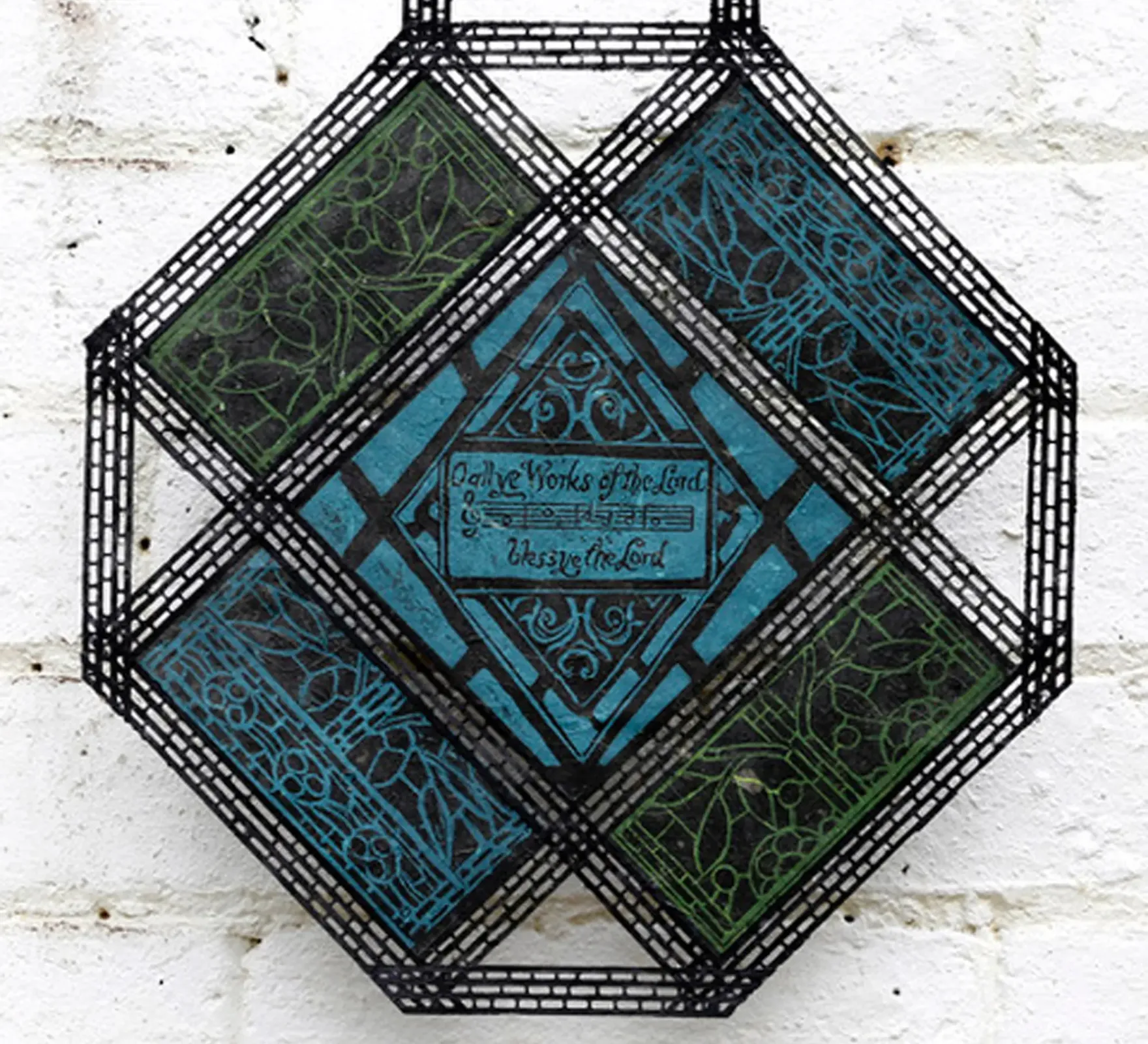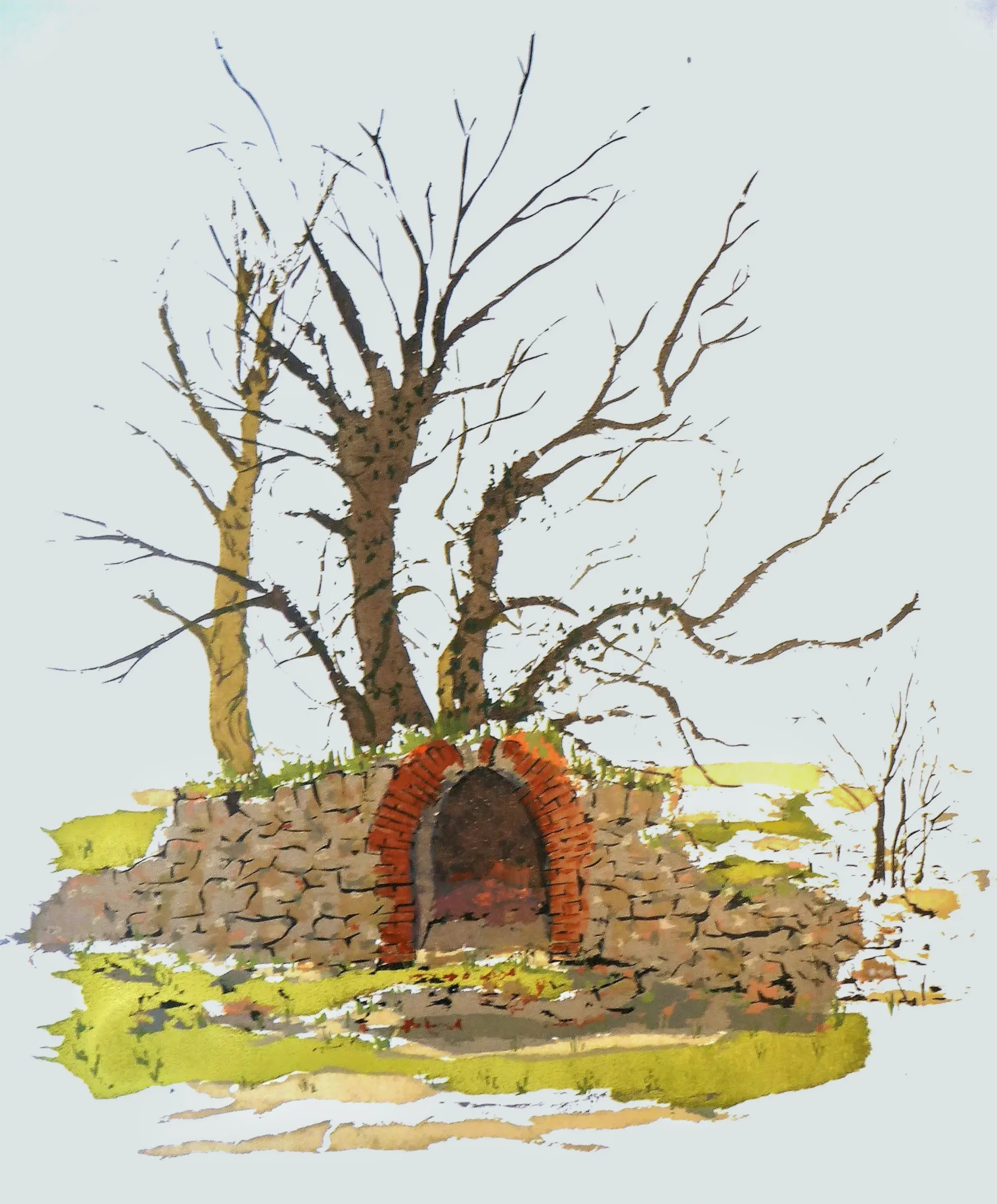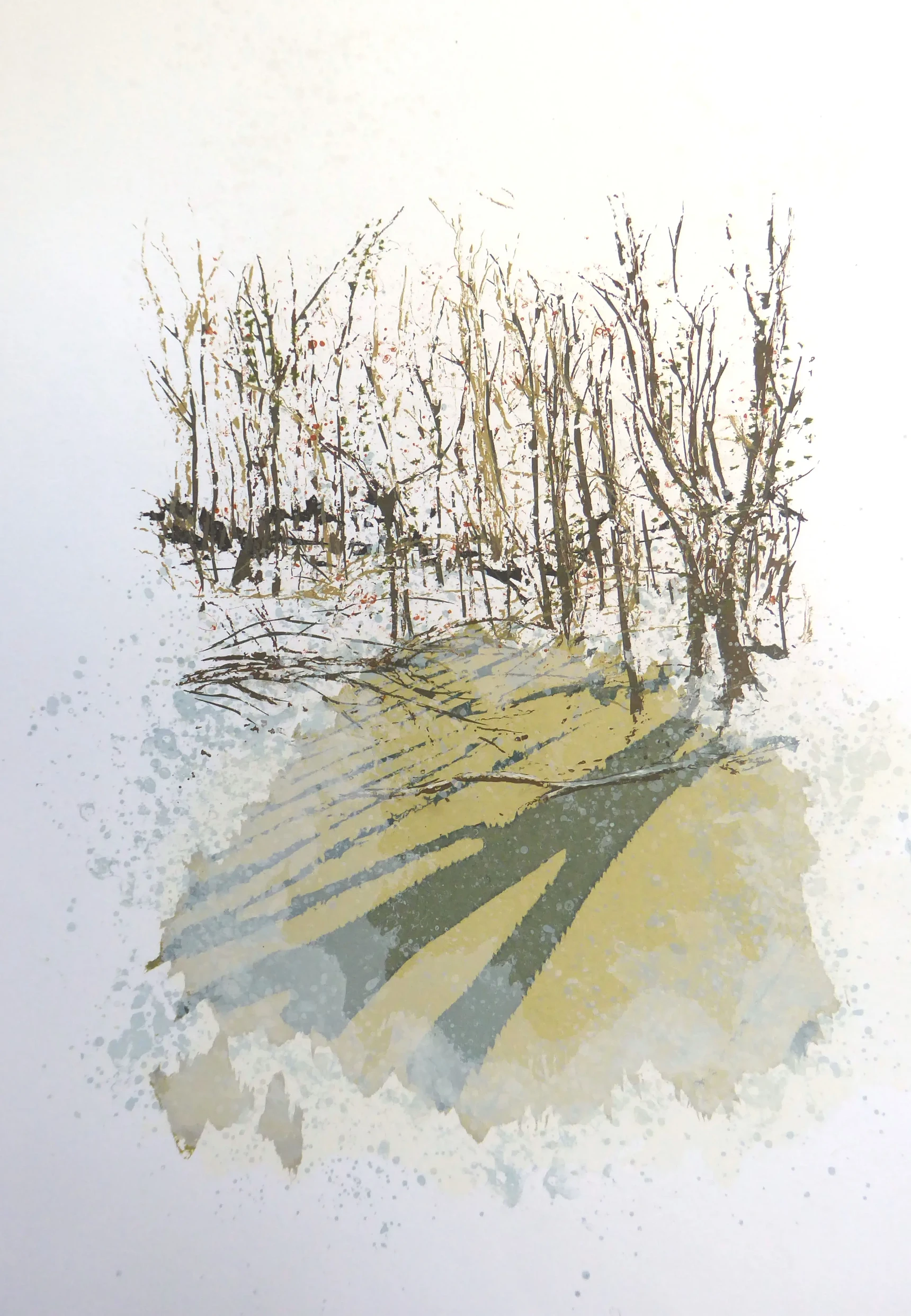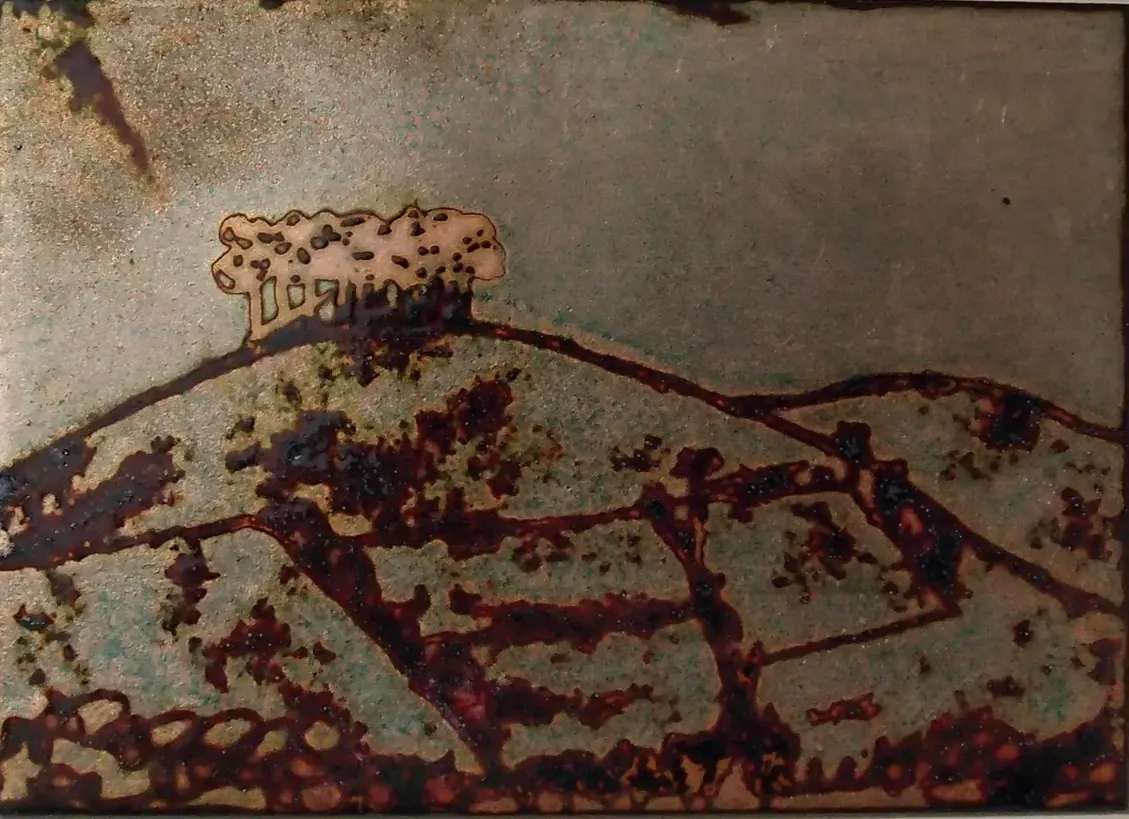Printmakers Pushing the Boundaries
Sunday, 27 March, - Friday, 27 May, 2022
-
Overview
-
Works
A group of six Printmakers and one Printmaker/Enameller have been working together, meeting and walking in the Marches, the boundary between Wales and England. Their aim is to explore a defined landscape to make individual expressions in print and other media, focusing on developing and extending their practices within this shared environment. This extensive exhibition will take place in the new Art Shed and Barn Gallery.
Artists: Alison Craig - Carolyn Hudson - Christine Matthews - Emma Aldridge - Estella Scholes - Jacqui Dodds - Jill Leventon
Alison Craig:
My work as a painter-printmaker emerges from the experience of walking through the countryside, and is informed by ideas of “deep mapping”: looking beyond the surface appearances to attempt a more detailed investigation of the environment. I make drawings on the move outside, suggesting how it felt to be moving through the landscape, rather than trying to produce an accurate visual record of the journey.
My sketchbooks are full of spindly lines - the walk - combined with notes about colour and sounds, fragments of leaves, and rapid drawings of horizons, trees or buildings.
In the studio, I use a variety of techniques including monoprint, linocut, etching and collage to combine the line of the walk with memories of things seen and heard. The finished piece resembles a kind of layered map, hinting at things which lie unseen under the earth; traces of previous generations; the exhilaration of the changing seasons; the memories of journeys made.
Carolyn Hudson:
When I retired, someone said ‘You should try printing, it may suit you’, and so I did, eventually completing a BTEC Level 2 in printing at the Regional Print Centre in Wrexham. I enjoy the experimental aspect of printing. It is a thoughtful process and the possibilities for exploring traditional methods of printing, new technologies and materials are endless, making for an interesting journey. My main interest is collagraph printing, a process where a range of materials are glued to a matrix to create tonal ranges. In addition, I like to combine this method of printing with other techniques. My work reflects my interest in the environment where we live and walk. What the paths, borders, waterways, edges buildings, homes and industry reveal of a constantly changing world: the ebb and flow of history covering the evidence of past times. There are great possibilities for design and composition: the ordinary becomes exciting as the past is researched and evoked.
Christine Matthews:
I gained my degree in fine art many years ago. I became interested in Printmaking while visiting my husband’s family in Poland. I visited a print exhibition and was in awe of the work on show. I was particularly fascinated by etching.
I am intrigued with the balance between art and science that etching offers. Etching allows me to explore the elements of line, tone, and form of which I have some control. During the etching process I harness the unpredictability of the method giving my work an element of chance when I explore colour and texture.
I have lived near the Border between England and Wales for most of my life. The area is renowned for its magnificent landscape and its rich tapestry of myths and legends.
Wherever I walk I sense the history of the landscape I am passing through, the past interrupts the present and reflecting on these experiences is the focus of my current work. In my work I am searching for the best way to interpret the ideas I have about these legends and the world I live in now.
Emma Aldridge:
My prints explore the tender and mischievous relationship I have with the world I inhabit.
I seek the character in my subjects which are either pulled from reflections on the past or drawn straight from nature. Birds and Industrial revolution landscapes feature frequently. Often as not I choose the discipline of screen printing to portray my affection for my present pre-occupations. With minimal planning and great patience, I build my images with layer after layer of impulsive marks created by cut and torn paper stencils which create in themselves marks and spaces as the ink soaks into the paper. Each layer informs the next layer; my colours are intuitive and soft registration creates sensations of movement and fragility in the story I am telling. I use photo stencils frugally if at all in the build of my images. No image is the entirely the same within the short editions I produce; they all have their own character.
Estella Scholes:
I print, paint, and make artists books.
I am fascinated by evidence of ancient manmade structures in the landscape. My research for this project has led me away from my usual coastal references, down intriguing geographic and historical pathways, and, increasingly, towards the world of myth and legend. These combine with visual memories of weathered textures, colours, and forms gradually eroded and reclaimed by nature, almost beyond recognition. My work comes from the space where physical world meets barely tangible ancient history, and both are overlaid with legend. Abstract images emerge onto paper, as prints or combined into handmade artists book structures. I work with several printmaking techniques, including collagraph, monoprint and etching, and allow each process to find its way towards the end result. Etchings are often printed from two plates, and collagraphs subtly alter with every inking. Each print is therefore unique, although there may be several variable combinations. I have recently started collaging print to include sections of the printmaking plate, and enjoy the gradual changes from one surface to another, which reflects the natural erosion of both the border landscapes and the memories they hold.
Jacqui Dodds:
I am an artist printmaker inspired by memories of places and objects within them. Images and feelings are retraced to create an essence of these spaces. My work is often identified uniquely for the colour and texture I use in my screen prints, as well as blind embossings that are devoid of colour.
This project has enabled me to explore heritage places along the present and ancient borders between England and Wales whilst engaging with my love of walking. I have been able to work further with my textural screen prints and colour palette, layering inks to obtain rich visual references. As a group we have walked and explored these places in changing seasons and weather. Chirk Viaduct and Aqueduct in early Autumn, Whittington Castle in the bare bones of Winter, Erddig in the rains of Autumn, Ffrith in Summer and Minera Lead Mine in Spring and other places, each with their own unique characteristics and feelings. We continued to meet online throughout this last year and physically met up when we were able to do so. The walks have been invigorating as well as inspiring new artwork.
Jill Leventon:
I trained as a mathematician and geologist, which probably accounts for my preoccupation with structure, both man made and natural. I am fascinated by the earthworks littered along the Welsh/English border, and by the medieval buildings in the area. Enamelling has a multitude of techniques, and I like to utilise several of them in my work. I enjoy finding new ways of doing things. I develop my work by trial and error, finding out what works and what doesn’t as I progress. I particularly enjoy firing enamels at temperatures far higher than their normal range, which causes the enamels to react with each other and with the copper. This can yield unusual and unexpected colours and textures, meaning that all those pieces are unique.

















